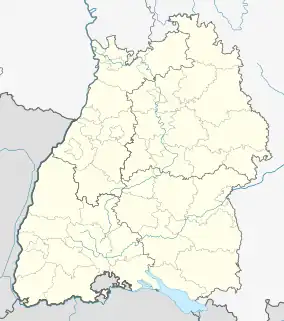Bad Säckingen
Bad Säckingen (High Alemannic: Bad Säckinge) is a rural town in the administrative district of Waldshut in the state of Baden-Württemberg in Germany. It is famous as the "Trumpeteer's City" because of the book Der Trompeter von Säckingen ("The Trumpeter of Säckingen"), a famous 19th-century novel by German author Joseph Victor von Scheffel.
Bad Säckingen | |
|---|---|
 Bad Säckingen; panorama from Swiss border | |
 Coat of arms | |
Location of Bad Säckingen within Waldshut district  | |
 Bad Säckingen  Bad Säckingen | |
| Coordinates: 47°33′N 7°57′E | |
| Country | Germany |
| State | Baden-Württemberg |
| Admin. region | Freiburg |
| District | Waldshut |
| Government | |
| • Mayor (2019–27) | Alexander Guhl[1] (SPD) |
| Area | |
| • Total | 25.34 km2 (9.78 sq mi) |
| Elevation | 291 m (955 ft) |
| Population (2021-12-31)[2] | |
| • Total | 17,552 |
| • Density | 690/km2 (1,800/sq mi) |
| Time zone | UTC+01:00 (CET) |
| • Summer (DST) | UTC+02:00 (CEST) |
| Postal codes | 79701–79713 |
| Dialling codes | 07761 |
| Vehicle registration | WT |
| Website | http://www.bad-saeckingen.de/ |
Geography
Bad Säckingen is located in the very southwest of Germany next to the Swiss border on the river Rhine. The city lies on the southern edge of the Black Forest area.
Nearby places
- Close (<15 km): Wallbach, Wehr (Baden), Murg am Hochrhein, Laufenburg (Baden), Stein AG, Rheinfelden (Schweiz), Rheinfelden (Baden), Rickenbach (Hotzenwald)
- Further away (>15 km): Waldshut-Tiengen, Schopfheim, Lörrach, Basel, Brugg AG, Aarau AG, Zürich, Schaffhausen SH, St. Blasien, Todtmoos, Freiburg i.Br., Konstanz.
History
The history of the city dates back to the early 6th Century, when Saint Fridolin founded Säckingen Abbey and a church. Around 1200 most of the city was destroyed in a huge fire. Afterwards, construction began in the middle of the town on a Gothic cathedral, called the Fridolinsmünster, which can still be visited today.
In the closing stages of the 1672–1678 Franco-Dutch War, the town was severely damaged by French soldiers commanded by the Comte de Choiseul, following their victory over an Imperial force at Rheinfelden on 7 July 1678.[3]
After the Second World War the city was under control of France from 1945-1952. The city was financially helped by the Swiss Fricktal to get over the financial struggles after the war.[4]
People
- Joseph Victor von Scheffel, (1826-1886), author of the book "Der Trompeter von Säckingen"
- Wibrandis Rosenblatt (1504-1564), was successively the wife of three important reformers Oecolampadius, Capito and Bucer
- Karl Agricola (1779-1852), painter and engraver

- Axel Neumann (born 1966), actor
- Baki Davrak (born 1971), actor
- Stefanie Böhler (born 1981), cross-country skier
Twin towns
- Sanary-sur-Mer, France (1973)
- Purkersdorf, Austria (1973)
- Nagai, Yamagata, Japan (1983)
- Santeramo, Italy (1983)
- Näfels, Switzerland (1988)
References
- Aktuelle Wahlergebnisse, Staatsanzeiger, accessed 15 September 2021.
- "Bevölkerung nach Nationalität und Geschlecht am 31. Dezember 2021" [Population by nationality and sex as of December 31, 2021] (CSV) (in German). Statistisches Landesamt Baden-Württemberg. June 2022.
- De Périni, Hardÿ (1896). Batailles françaises, Volume V. Ernest Flammarion, Paris. p. 222.
- "Stadtgeschichte". Stadt Bad Säckingen (in German). Retrieved 2023-09-25.
External links
![]() Media related to Bad Säckingen at Wikimedia Commons
Media related to Bad Säckingen at Wikimedia Commons
- Official website
- (in German) Bad Säckingen:History and images Archived 2009-09-06 at the Wayback Machine